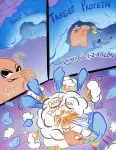(MEMPHIS, Tenn. – November 11, 2024) There are processes in the human body that can suppress the growth and proliferation of cancer cells. These mechanisms, including those involving the tumor suppressor protein p53, are widely studied due to their critical role in disease. Through studies of proteins that regulate p53, scientists at St. Jude Children’s Research Hospital have uncoupled a previously unrecognized tumor suppression mechanism. Usually found at low levels in cells, the p14 Alternative Reading Frame protein (p14ARF) is expressed at higher levels under oncogenic stress and activates p53. The researchers identified an alternative tumor suppression mechanism for p14ARF, showing how condensate formation and ribosome production disruption contribute to the process. The findings were published today in Nature Communications.
The researchers demonstrated that increased expression of p14ARF causes the protein to phase separate with other cellular components. This occurs within the nucleolus, a membraneless compartment in the nucleus of cells responsible for ribosome production. In the nucleolus, p14ARF binds to and phase separates with nucleophosmin, an essential protein for ribosome production, creating a gel-like state, leading to decreased nucleophosmin dynamics, stalled ribosome biogenesis and cell toxicity. The process, kickstarted by p14ARF, thus represents a likely alternative tumor suppressive pathway.
p14ARF gums up the works in the nucleolus
“p14ARF is normally expressed at very low levels in healthy cells, but increased expression is induced in response to oncogenic stress, such as upregulation of MYC or other oncogenes,” explains corresponding author Richard Kriwacki, PhD, St. Jude Department of Structural Biology.
Kriwacki’s investigations into p14ARF function began when the protein, upon increased expression, was found to localize to the nucleolus. Through interaction with nucleophosmin, a protein abundant within the nucleolus that acts as director of the ribosome factory, p14ARF becomes a spanner in the works of the nucleolus, disrupting its normal function.
“Upon overexpression, p14ARF can go to the nucleolus and block nucleophosmin from acting as a chaperone and shuttling pre-ribosomal particles out,” explained first author Eric Gibbs, Department of Structural Biology. “So, nucleophosmin gets stuck in the nucleolus, and consequently, the ribosomal particles get stuck.”
Gibbs and Kriwacki showed previously that, in isolation, p14ARF and nucleophosmin form biomolecular condensates. The formation of condensates, which often appear as droplets under a microscope, has been shown to regulate an increasingly abundant number of biological processes, ranging from transcription to cell signaling. Generally, condensates do this by temporarily increasing the localized concentration of specific biomolecules such as DNA, RNA and proteins. However, biomolecules need a sequence-specific “ticket to ride” to participate in phase separation.
p14ARF networking is key to tumor suppression
Gibbs and Kriwacki leveraged biophysical techniques, including small-angle neutron scattering (performed at Oak Ridge National Laboratory) and nuclear magnetic resonance spectroscopy, to explore the peculiar nature of p14ARF-nucleophosmin condensates. “We found that p14ARF was not only phase separating with nucleophosmin but also assembling a large network structure that had some symmetry,” explained Gibbs. “This network was responsible for restricting the dynamics of p14ARF and nucleophosmin inside the condensates.”
Furthermore, while p14ARF is generally considered an intrinsically disordered protein lacking stable structure, the researchers noticed that it showed elements of secondary structure within the condensates, which facilitate the formation of the network. “We found that hydrophobic interfaces in the secondary structure regions form the different crosslinks to assemble the network and essentially give the condensate its unique characteristics,” explained Gibbs. The ordered nature of the network led to the condensates taking on a gel-like state, effectively locking nucleophosmin in place.
The findings illuminate a previously unknown route by which p14ARF contributes to tumor suppression. Additionally, since condensates usually rely on fluid dynamics to achieve their function, with solidification often associated with a disease-causing state, this work provides a unique perspective on biomolecular condensation.
“I think it’s fascinating that an aspect of how p14ARF acts as a tumor suppressor is through immobilization of the liquid-like nucleolus and apparent inhibition of critical steps in ribosome biogenesis,” explained Kriwacki. “We can now view how p14ARF acts as a tumor suppressor through the lens of what we normally view as a deleterious effect within the nucleolus.”
Authors and funding
The study’s other authors are Aila Hassan, Rainer Kümmerle, and Barbara Perrone; Bruker Switzerland AG; Gergely Nagy, Wellington Leite, William Heller and Chris Stanley; Oak Ridge National Laboratory; and Qi Miao, Mylene Ferrolino, Richa Bajpai, Aaron Phillips, Aaron Pitre and Shondra Miller; St. Jude.
The study was supported by grants from the National Institute of General Medical Sciences (5R35GM131891, 1F32GM133078) and ALSAC, the fundraising and awareness organization of St. Jude.
St. Jude Media Relations Contacts
Chelsea Bryant
Desk: (901) 595-0564
Cell: (256) 244-2048
chelsea.bryant@stjude.org
media@stjude.org
Rae Lyn Hartley
Desk: (901) 595-4419
Cell: (901) 686-2597
raelyn.hartley@stjude.org
media@stjude.org
St. Jude Children’s Research Hospital
St. Jude Children’s Research Hospital is leading the way the world understands, treats and cures childhood cancer, sickle cell disease and other life-threatening disorders. It is the only National Cancer Institute-designated Comprehensive Cancer Center devoted solely to children. Treatments developed at St. Jude have helped push the overall childhood cancer survival rate from 20% to 80% since the hospital opened more than 60 years ago. St. Jude shares the breakthroughs it makes to help doctors and researchers at local hospitals and cancer centers around the world improve the quality of treatment and care for even more children. To learn more, visit stjude.org, read Progress: A Digital Magazine and follow St. Jude on social media at @stjuderesearch.
END








